Our Learning Network
“Working with Funding the Next Generation Project makes me confident that we will prevail in moving the needle for children and youth in our local communities.”
– Claudia Jasin, City of Sacramento
Since our founding, we have sponsored a cohort of diverse local coalitions that have the motivation, community commitment and leadership to fight for resources for children and youth. The communities represent a wide range of populations in terms of culture, ethnicity, and socio-economic status. The cohort is a learning community – sharing successes, ideas and challenges. The participating communities have been supported in budget research, strategic planning, community organizing, coalition building, messaging, polling, technology, and fundraising.
The representatives of the cities and counties who have participated in our learning community often worked collaboratively to promote the goal of creating dedicated revenue streams for children, youth and their families throughout the state.
Link to mission statement of the network.
“Coming together makes us realize the parallels in our efforts, and the shared priorities that could make our work more likely to be successful.” — Elliott Balch, Chief Operating Officer, Central Valley Community Foundation
“I get inspiration from the learning community meetings – with so many people who are so dedicated to long term success.” — Eric Gurna, Former President and CEO, LA’s BEST
San Francisco was the Pioneer
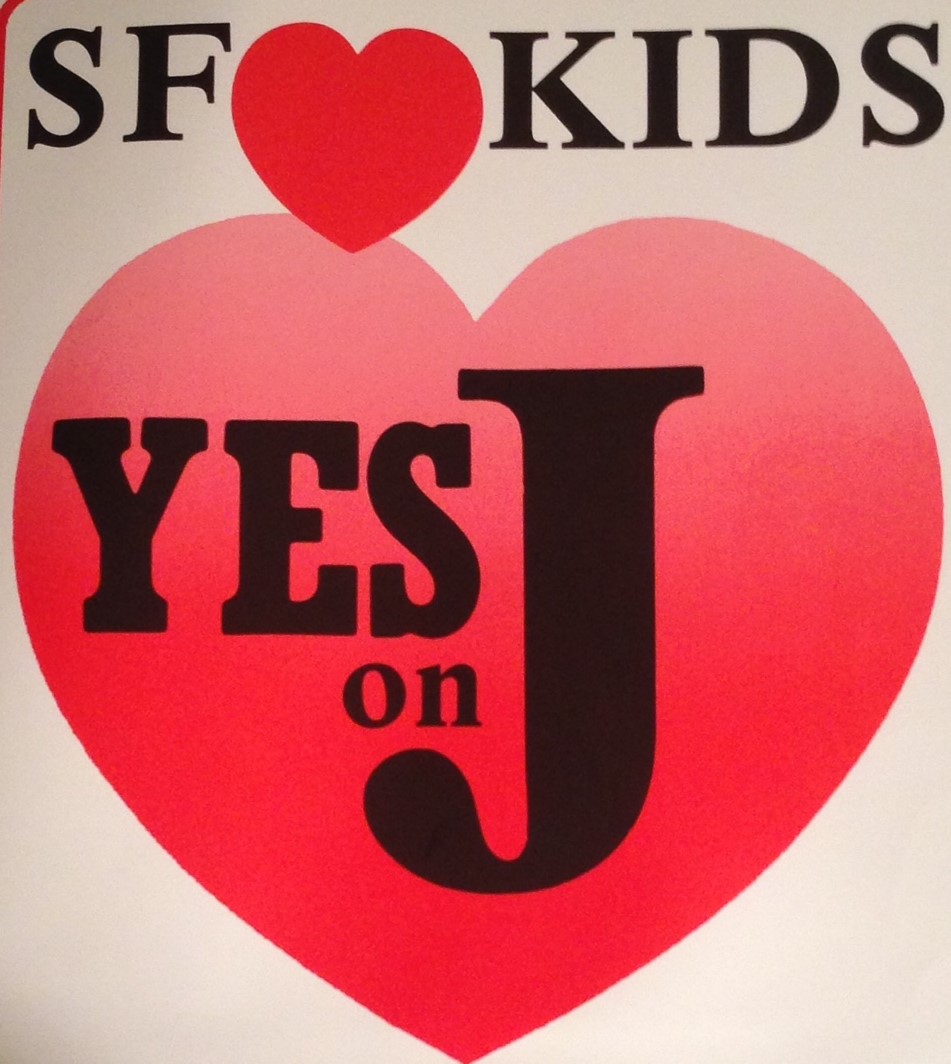 In 1991 San Francisco passed the state’s first dedicated fund for children and youth, and next to Florida’s xx County, was the first in the country. It has inspired the creation of funds throughout the state and country. The measure, known as Prop J, was opposed by all elected officials until advocates gathered over 60,000 signatures to place it on the ballot themselves. The San Francisco fund, now known as the Children and Youth Fund, has been re-authorized twice, each time garnering over 70% of the vote. The San Francisco fund is the largest per population in the country.
In 1991 San Francisco passed the state’s first dedicated fund for children and youth, and next to Florida’s xx County, was the first in the country. It has inspired the creation of funds throughout the state and country. The measure, known as Prop J, was opposed by all elected officials until advocates gathered over 60,000 signatures to place it on the ballot themselves. The San Francisco fund, now known as the Children and Youth Fund, has been re-authorized twice, each time garnering over 70% of the vote. The San Francisco fund is the largest per population in the country.
The Children and Youth Fund has inspired two additional local funds in San Francisco, one for preschool for all, the other for childcare subsidies and salaries. Between the 3 funds that the San Francisco electorate has passed, over $250M local dollars each year go to children and youth. In its second reauthorization, the original Children and Youth Fund expanded the ages it covers to age 24. There is much material under Section 1 of the Resource Library on this website on San Francisco’s multi-year campaign to create the first fund, and subsequent funds.
 The Children and Youth Fund is a set-aside of property taxes, the Preschool for All fund is a set-aside of the general fund and the childcare subsidy and wages measure, known as Prop C, is a commercial rent gross receipts tax. There is a detailed Prop C story linked below.
The Children and Youth Fund is a set-aside of property taxes, the Preschool for All fund is a set-aside of the general fund and the childcare subsidy and wages measure, known as Prop C, is a commercial rent gross receipts tax. There is a detailed Prop C story linked below.
Oakland followed San Francisco
The San Francisco’s first Children’s Fund measure was replicated by Oakland in 1996 creating the Oakland Fund for Children and Youth. Since 1996, there have been six measures passed that increase resources for Oakland’s children – that provide approximately $135M each year. Some are described below (Alameda County and Oakland Children’s Initiative). The others are decribed in our booklet, “Oakland: A City that Votes for Kids.”
- Sandboxes to Ballot Boxes – An early history of San Francisco’s Children’s Fund by Margaret Brodkin
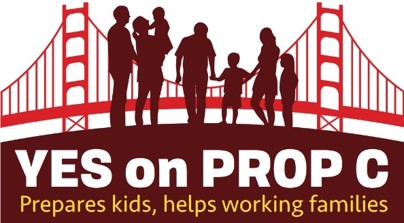
- 2000 Reauthorization of San Francisco’s Children and Youth Fund
- 2014 Reauthorization of Children and Youth Fund and Public Education Enrichment Fund
- Fact Sheet on SF Children and Youth Fund
- Website of SF Department of Children, Youth and Their Families – the agency which oversees the children and youth fund
- Fact Sheet on childcare subsidy and wages measure of 2018, known at Baby Prop C
- Website of Oakland Fund for Children and Youth
- Newspaper story of (baby) Prop C, the Commercial Rent Tax to Fund Childcare and Early Education – “Could San Francisco Be a Solution to the Childcare Crisis?”
Described below is the work of many groups we have supported since 2015. They reflect many types of strategies and outcomes. They are all a work in progress even when (or especially when) a measure is passed. Our hope in telling these stories is that we will all learn important lessons about getting the local resources our children and youth need to thrive.
Taking the Lead in the Next Generation of Children and Youth Funds
After the funds passed in San Francisco and Oakland in the 90’s, no other community was able to create a fund until 2016 in Richmond, California. Richmond began the next iteration of children and youth local funding measures in California.
City of Richmond
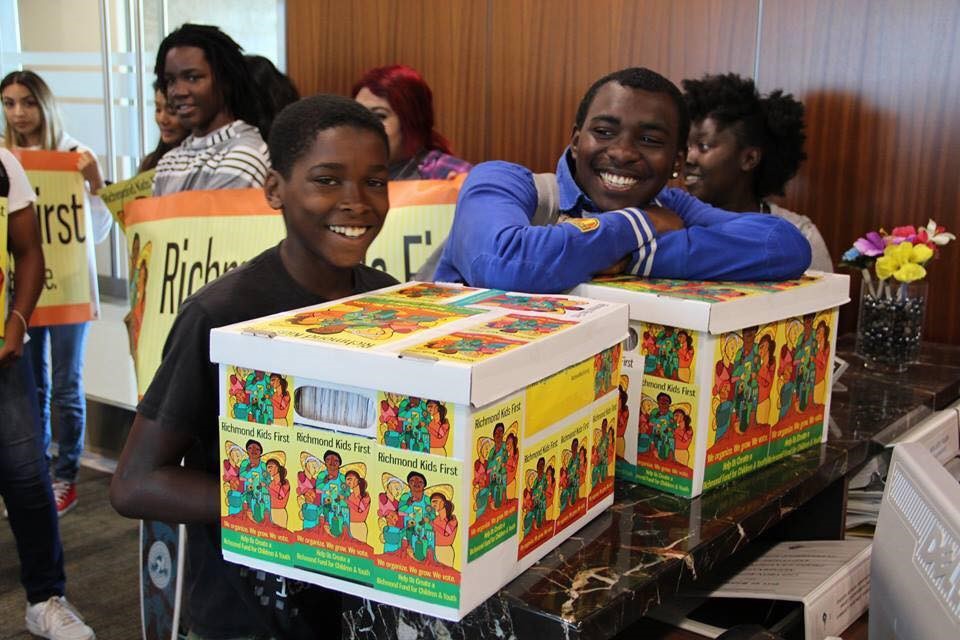
Young people submitting petitions for Richmond Fund for Children and Youth to Contra Costa County elections office.
STARTING THE JOURNEY – For years, folks at the RYSE Center in Richmond dreamed about having a Youth Fund, and in 2014, they got serious. First they organized the Invest in Youth Coalition (IYC), with their allies and colleagues in the community. After months of meetings and building consensus, the IYC agreed that its first collective goal would be to work to pass a Youth Fund, modeled after the Funds in San Francisco and Oakland. They then spent several months developing a measure that was consistent with their philosophy about young people. It was a group process, and young people had a full voice. The lawyer who drafted the final measure on behalf of Richmond Kids First, the name of the campaign, said it was the most extensive measure she had ever seen.
The goals in the measure were:
- To ensure that Richmond’s children, youth and young adults are physically, emotionally, mentally and socially healthy, educated, successful in school, and live in stable, safe and supported families and communities;
- To increase safety for children, youth, young adults, their parents/guardians, families and the communities in which they live by preventing problems and enhancing the strengths of children, youth, young adults and their families;
- To ensure young people are provided with gender-responsive, trauma-informed, population-specific and culturally-competent services;
- To strengthen collaboration among public agencies and community-based organizations around shared outcomes among all service providers for children, youth, young adults and their parents/guardians;
- To ensure an equitable distribution of resources to all of Richmond’s young people in recognition of the importance of investment in their futures from birth through young adulthood;
- To fill gaps in services and leverage other resources whenever feasible.
THREE BALLOT MEASURES NEEDED – ALL PASSED – A petition drive ensured getting the measure on the ballot and young people led the way collecting signatures. It was a heroic organizing effort. In the end, despite vigorous advocacy efforts, the City Council used its discretion to keep the measure off the 2016 ballot. However, the signatures were validated and, the measure passed in June 2018 by 76% of the vote. However, reaching a successful measure was not easy, and it took 2 other measures to make it real – a second measure in June 2018 requiring a new revenue stream for the Fund, and the passage of a Real Estate Transfer Tax in November 2018 to raise the money to pay for the Fund. As a result of all the negotiations around the 3 measures, in the end they all had widespread support from city officials, labor and youth advocates. AND, to make matters even more complicated, the Richmond Kids First group engaged in a fourth campaign, for a gross receipts tax to go into the General Fund and ensure sufficient funds for the Richmond Youth Fund.
GREAT OUTCOMES – The Richmond story moves on with fantastic news. The City Department for Children and Youth got created (per the measure) and is works closely with the community to plan for and allocate the funds. The first round of funding for the Richmond Youth Fund has been allocated. Check out all the materials now on the website of the Richmond Department of Children and Youth! It took a long time to get there, but the outcome makes it all worthwhile.
- Link to Richmond Kids First Measure
- Link to website of the Richmond Department of Children and Youth (created by the legislation for the fund)
- Link to website of the Strategic Investment Plan for the Fund
Persistence Leads to Success
City of Sacramento – Third time is a charm.
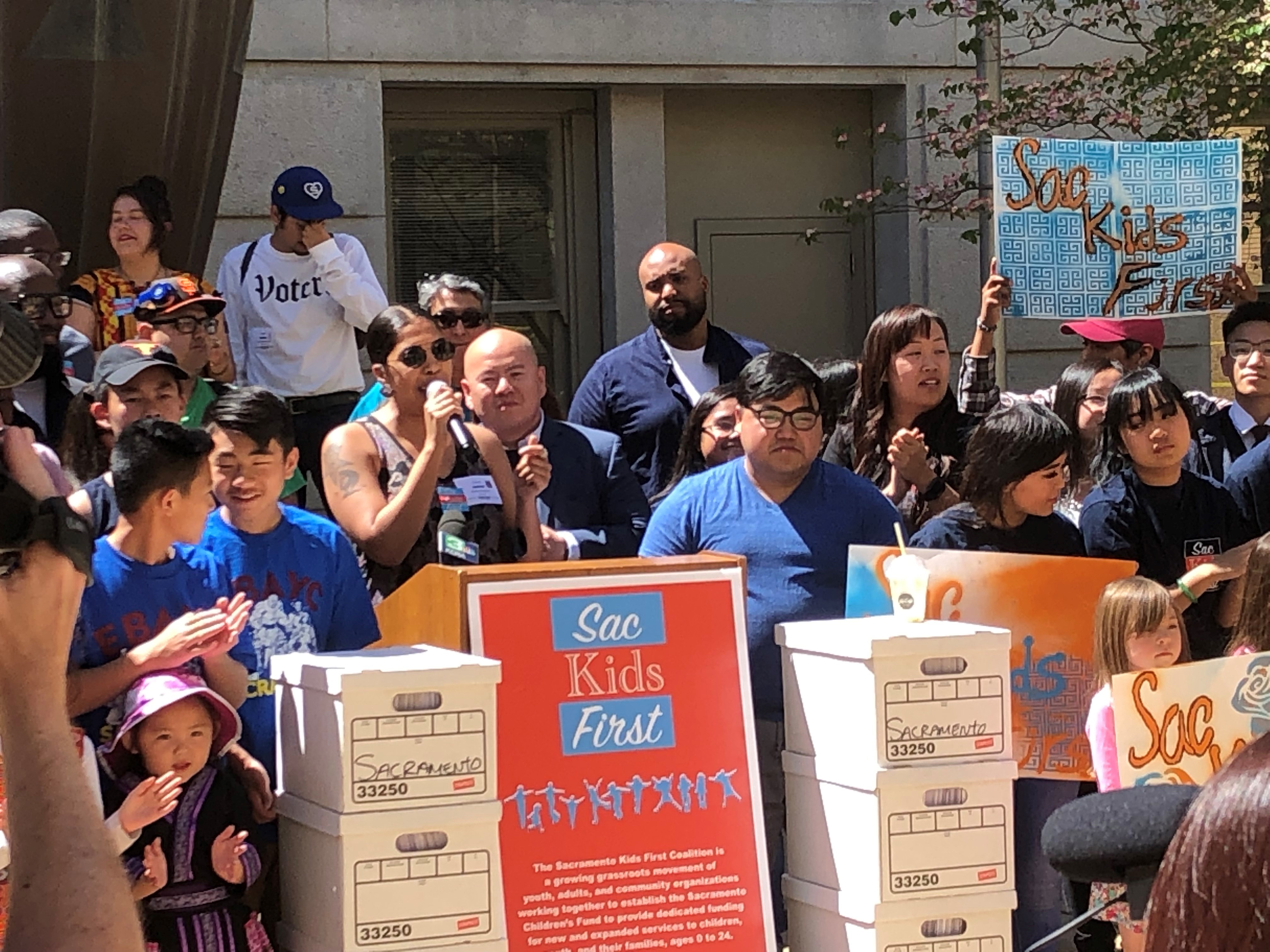
Sac Kids First coalition submitting 39,017 signatures for a Children’s Fund to the Registrar of Voters in Sacramento
Getting a dedicated fund for children and youth in Sacramento has taken three attempts at the ballot. The first was led by City Council member Jay Schenirer. The 2016 measure called for the marijuana tax proceeds to be placed in a dedicated fund for youth services. Despite opposition by the city’s main newspaper, the measure gleaned 65.8% of the vote, just short of the 2/3 needed to pass. This demonstrated strong support for youth in the City of Sacramento.
This near-success spurred on a new and diverse grassroots coalition called Sac Kids First, brought together by the East Bay Asian Youth Center, to develop a second measure: a set aside of 2.5% of the city’s General Fund for a Children’s Fund for services to children and youth less than 25 years old.
The goals of the Fund were to:
- Support youth to live safe, peaceful and healthy lives free from involvement with the juvenile and criminal justice systems.
- Help children and youth succeed in school and graduate high school prepared for college, career, and community.
- Foster the healthy development of young children, ages 0 – 5 years old.
The Fund was expected to accrue $12 Million a year, to be overseen by a Sacramento Children’s Fund Planning and Oversight Commission. Allowable uses would have included mentoring, job training, culturally-based hearing practices, summer and after-school learning, early childhood education and parent support services.
Sac Kids First drafted the measure and collected signatures to place it on the ballot. Ultimately the measure only received 45% of the vote due primarily to opposition by the Mayor and by a vigorous opposition campaign waged by the city’s firefighters’ union. The youth involved in the campaign, however, were not discouraged. They felt like they gained momentum and planned to keep fighting. AND, while the Mayor opposed the SacKids measure, he promised to propose “a better way” – his own ballot measure for a youth fund. Meanwhile the City Council passed a resolution declaring youth development a public safety issue. The proponents of the children and youth fund see this as one more step in increasing resources to the children and youth of Sacramento.
A very insightful analysis of the Sac Kids 2020 campaign was written by Jim Keddy, Executive Director of Youth Forward and one of the forces behind the campaign.
In 2022, the Sac Kids Coalition began negotiating with the Mayor and the City Council to place the third measure on the ballot. This time the measure is the result of a collaboration between advocates and city officials and was on the November 2022 ballot. A tragic gun violence event occurred in April 2022 which not only shook Sacrament, but shocked and traumatized the state. Advocates for the next iteration of the youth fund are using this tragedy to point to the necessity of prevention and resources for youth, Check out the editorial and article below that make the case.
The third measure garnered widespread support from the local newspaper, local public officials, youth organizations and a wide variety of civic leaders. The measure is the result of many compromises and negotiations. The revenue source for the Fund is a set-aside of the city’s General Fund equal to the revenue generated by the city’s cannabis tax. After a robust campaign, with youth organized by Sac Kids First, the measure passed by 62%. Those working on the campaigns attribute their success to an active youth movement, the leadership of a dedicated City Council member, and, of course, persistence. Their cry, “Never give up.”
Sacramento leaders did more than work on a funding stream to make the city youth-friendly. A variety of policy measures were passed to create a foundation of youth support: placing youth on various official policy bodies including the City Council, and a policy declaring youth development as a public safety measure (with implications for budget decisions.)
- Sacramento City Council resolution making youth development a public safety issue
- Website of Sac Kids First
- Copy of second Sac Kids First measure
- Sac Kids second campaign intro mailer
- Sac Kids second campaign postcard
- Copy of third measure in 2022
- Third Campaign video
- Legislation creating youth seats on various commissions – e.g., Rec and Park, arts, economy, police review
- Legislation creating a youth representative/liaison on the City Council
- Youth Development is Public Safety – policy position passed by City Council
Alameda County – Diverse coalition of parents, advocates, providers, policy experts, political champions and community foundation

Stakeholders from throughout Alameda County have been talking in many forums over the years about the needs of young children and the need for adequate resources. In 2017 all of the pieces began to fall in place for a 2018 sales tax measure. A lesson learned for the field is that it is sometimes a long build-up to get to a point where a ballot measure is the right course of action.
The elements that came together for Alameda County are:
- An early care network of professionals who could provide the backbone of information needed for a stellar proposal.
- A parent organizing group (Parent Voices) that was fully engaged and brought reality and passion to the public forum.
- Two members of the Board of Supervisors who agreed to be champions of the cause – using their stature, expertise and staff to provide necessary support.
- SEIU as a partner in the cause, bringing organizing expertise and putting a spotlight on the key issue of childcare wages.
The totally unique element of the campaign is the role that the East Bay Community Foundation is playing. Community foundations are legally able to give money directly to political issue campaigns. Sadly, it rarely happens, and many foundations and others believe it is not legal. Not only is the East Bay Community Foundation donating to the campaign, but it has established a fund that allows all types of foundations to pool their money and also give money legally. By the end of 2017, the pooled fund was a million dollars – a long way toward the cost of a campaign. Funding the Next Generation is recommending that other community foundations use this as a model. One of the biggest challenges for Children’s Fund campaigns is raising dollars. There is no moneyed interest with the resources to fund a campaign, as there is in school bonds, for instance, where contractors will benefit. For that reason, this strategy being pioneered by the East Bay Community Foundation is particularly important to the children’s movement.
A half-cent sales tax was placed on the ballot in June 2018. It came within an inch of winning, gleaning 66.2% of the vote – just short of the 2/3 needed. BUT the sponsoring organizations and leaders did not give up, and put the measure on the ballot again for 2020. This time they circulated a petition to get signatures in hopes that the voter threshold will be lowered (through a clarification by the California Supreme Court) for measures placed on the ballot by voters. One other difference was that Oakland Children’s Hospital joined forces with the other groups, and proceeds from the tax will be shared with them to fund prevention services. In the end, the signatures have paid off, as the measure received 64% of the vote and was certified as having passed by the County. It took several years for a court opinion by the state Supreme Court to determine that measures placed on the ballot by the voters only needed a majority of voter approval. In April 2021 the pivotal decision happened, and the county is collecting the money and putting the plan in place under the auspice of First 5 Alameda.
- Q and A on Measure C, 2020 campaign
- Fact Sheet on Measure C, 2020
- Copy of Measure C, 2020
- Power point on the 2018 campaign
- Fact sheet on the campaign on the 2018 campaign
Santa Cruz City and County – Starting with legislation, then ballot measure
In 2017 First 5 Santa Cruz took the initiative to explore revenue options at the county level. An early step was to advocate for the Board of Supervisors to create a Thrive by Three Fund. That Fund is serving as a stake in the ground in the county to go from being a pilot project to being a permanent part of the budget.
Simultaneously, at the city level, with the leadership of Councilwoman Martine Watkins, the City Council passed, an increase in the city marijuana tax (amounting to 12% of the tax revenue), to create a new dedicated children and youth fund. Despite fiscal problems in the city over the next 4 years, the City of Santa Cruz Children’s Fund stayed in place. The city fund is used in part to support the county’s Thrive by Three Fund, and also provides scholarships for programs for the city’s low income children and youth. And not to be outdone by Santa Cruz, the very small city of Capitola nearby dedicated a portion of its hotel tax to early childhood and youth programs. The tax was approved by the voters in 2018 with the ongoing set-aside for kids.
The big news: In 2021 the City Council introduced a ballot measure to institutionalize the cannabis tax revenues for a City of Sant Cruz Children’s Fund. The measure which was on the November 2021 ballot received 82.7% of the vote, and will dedicate 20% of cannabis tax revenues to programs for kids! This was a combination of two popular ideas: taxing cannabis and setting aside existing revenue. Most voters felt that they would not actually be paying the tax, and the cannabis industry supported having the existing tax go to children and youth. The winning strategy: starting with a legislative mandate, and then using the ballot to institutionalize it only after it demonstrated success.

- Testimony by Councilwoman Watkins on the need to use marijuana revenue for a children and youth fund in 2017
- Link to Description of Thrive by Three Fund
- Letter to Board of Supervisors advocating for the fund
- Website for Santa Cruz cannabis campaign in 2021
- Santa Cruz ballot measure of 2021
Oakland – Early Care and Youth Together on the Ballot
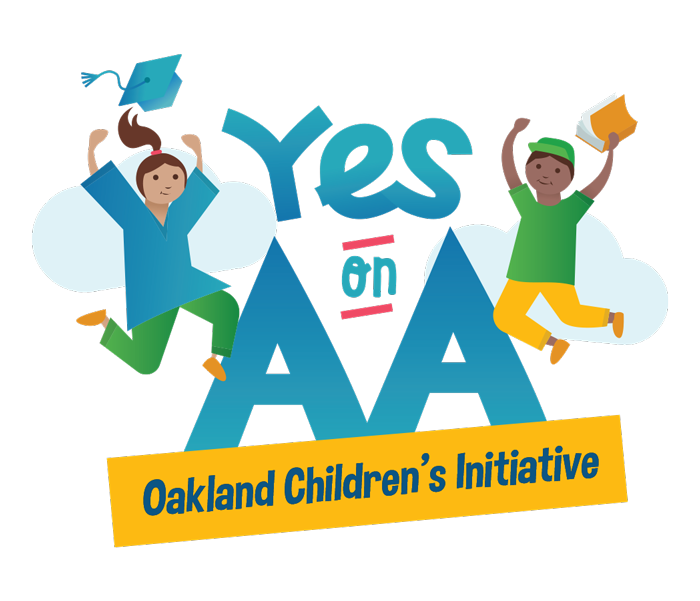 With the leadership (and fundraising prowess) of Oakland’s Mayor, in 2018 Libby Schaaf, Oakland mounted a vigorous campaign to pass a parcel tax to fund both preschool and Oakland Promise, a high school and college scholarship program. It was based on years of research documenting the need. A coalition organized by the Mayor mounted a signature campaign to place it on the ballot. It was opposed by the real estate industry, which succeeded in preventing the measure from receiving 2/3 of the vote. Instead the measure received only 61.8%. The City Council determined that because the measure had been put on the ballot as a voter initiative that, based on other court decisions around the state, it had passed. Opponents took that decision of the City Council to Court, insisting that a 2/3 vote was needed. It took over 3 years for the issue to make it through the court system, but in December 2021, the California Court of Appeals determined that the measure had indeed passed and the city began collecting the $30M that is to be generated each year. The city is now working hard to see that the programs to be funded through the measure are implemented.
With the leadership (and fundraising prowess) of Oakland’s Mayor, in 2018 Libby Schaaf, Oakland mounted a vigorous campaign to pass a parcel tax to fund both preschool and Oakland Promise, a high school and college scholarship program. It was based on years of research documenting the need. A coalition organized by the Mayor mounted a signature campaign to place it on the ballot. It was opposed by the real estate industry, which succeeded in preventing the measure from receiving 2/3 of the vote. Instead the measure received only 61.8%. The City Council determined that because the measure had been put on the ballot as a voter initiative that, based on other court decisions around the state, it had passed. Opponents took that decision of the City Council to Court, insisting that a 2/3 vote was needed. It took over 3 years for the issue to make it through the court system, but in December 2021, the California Court of Appeals determined that the measure had indeed passed and the city began collecting the $30M that is to be generated each year. The city is now working hard to see that the programs to be funded through the measure are implemented.
Moving forward: Groundbreaking Coalition and Progressive Revenue Proposal
Monterey – Building a diverse coalition
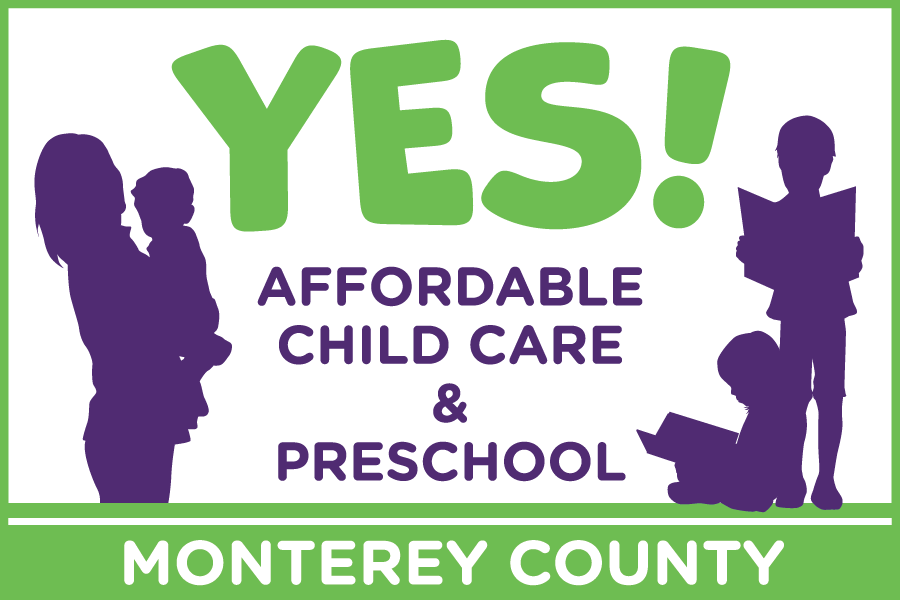 For many years advocates for children in Monterey County have been working to improve and expand services – exploring multiple funding options, building partnerships and communicating persuasively about the urgency of early childhood services. They worked hard to bring together a very diverse coalition of supporters that included everyone from leaders of the business community to social justice advocates. They have aimed to prove that caring for children is the one issue that cuts across the traditional polarization in politics.
For many years advocates for children in Monterey County have been working to improve and expand services – exploring multiple funding options, building partnerships and communicating persuasively about the urgency of early childhood services. They worked hard to bring together a very diverse coalition of supporters that included everyone from leaders of the business community to social justice advocates. They have aimed to prove that caring for children is the one issue that cuts across the traditional polarization in politics.
In 2021 they saw an opportunity to bring a measure to the ballot – with the pandemic bringing an even broader understanding of the essential need for child care. In 2022 they began collecting signatures for their measure to raise millions for child care through a $49 parcel tax. They worked persuasively with groups that typically oppose taxes to help them understand that child care is essential for business recovery and economic development. Measure Q, was known as the “Safe, Affordable. Quality Child Care in Monterey County Act.” Its 300+ endorsers included: all members of the Board of Supervisors, federal electeds, mayors of all the major cities, religious leaders, healthcare administrators, grassroots organizations like LULAC, COPA, and Mujeres en Action, SEIU, United Way, Hospitality Association, Salinas Valley Chamber of Commerce, Building Healthy Communities, Monterey Peninsula Chamber of Commerce, Community Foundation of Monterey County, and the Monterey Bay Aquarium. It was an amazing coming together of many voices – including anti-taxers. In the end, they garnered 41% of the vote. Low voter turnout and the inflation conspired to tamp down the “yes” vote. But the success of running a powerful and inclusive campaign has set child advocates up for the next step in raising local dollars for kids.
South San Francisco – Working for equity, corporations should pay their fair share.
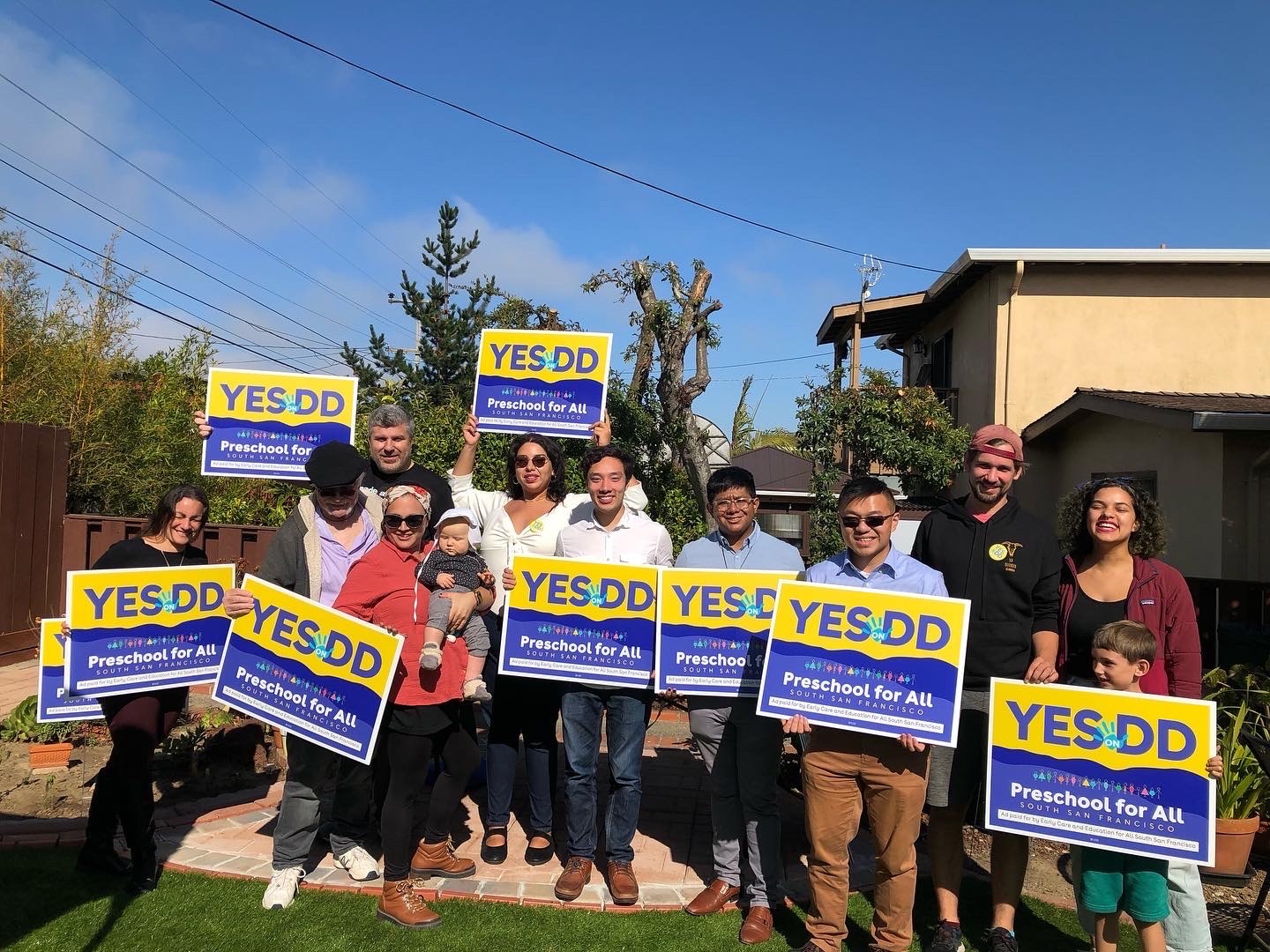 In early 2021, a grassroots coalition of activists, childcare unions, and parents began to put together a ballot measure that would provide free universal preschool and child care for every parent in their city, and would pay every early care provider a truly living wage that would start at around $70,000 a year. The measure was a commercial parcel tax on properties of over 25,000 square feet – meaning it would only impact the large corporations that have offices within the city boundaries.
In early 2021, a grassroots coalition of activists, childcare unions, and parents began to put together a ballot measure that would provide free universal preschool and child care for every parent in their city, and would pay every early care provider a truly living wage that would start at around $70,000 a year. The measure was a commercial parcel tax on properties of over 25,000 square feet – meaning it would only impact the large corporations that have offices within the city boundaries.
This was perhaps the most expansive (and progressive) measure that has ever been on a ballot for children’s services on the United States. It would have raised between $53M and $68M – enough money to meet the very ambitious goals of the sponsoring coalition. The coalition collected 6000 signatures, done entirely by volunteers, and the measure was placed on the ballot.
The measure proved to be very controversial, since the biotech industry (led by Genentech) raised half a million to mount the opposition. Residents of South San Francisco were inundated with mailing, social media and TV ads. But the primarily volunteer effort was feisty and fought back. It was truly a David and Goliath venture. Sadly, at the end of the day, the campaign garnered 47% of the vote – not quite enough to bring them over the top. Considering the opposition and the ballot measure question (that was written by the City Council where the majority opposed the measure), it did amazingly well. It demonstrated that a progressive tax measure can work and that a small group can mount a credible and powerful campaign against a corporate interest.
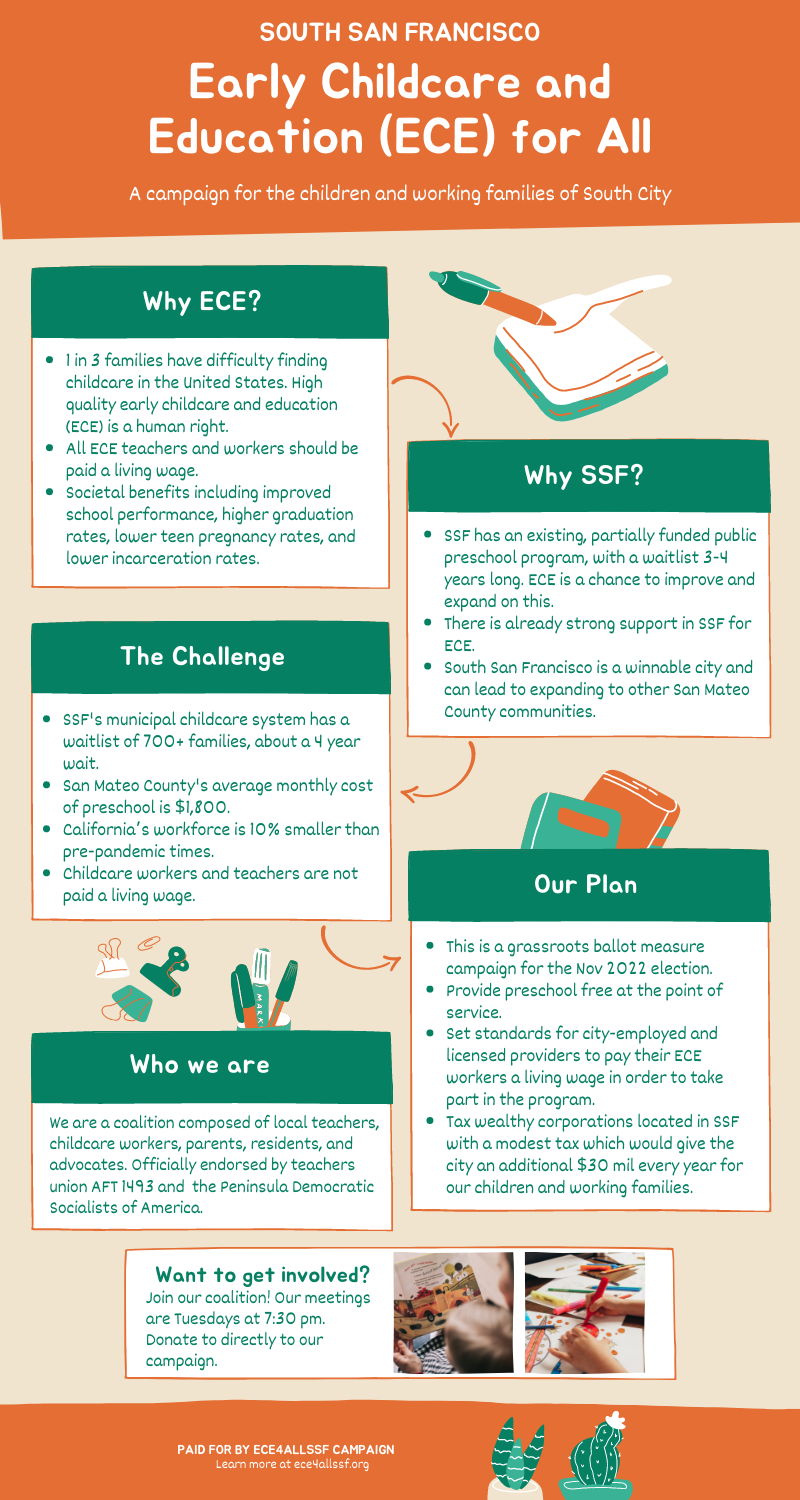
Link to Measure – known as Measure DD
Building toward a Ballot Measure
City of Pomona – Youth-led campaign built on strong social justice foundation
Gente Organizada, is a community-led social action non-profit organization based in Pomona whose mission is to bring together generations to access, build and wield their collective power to achieve educational, economic, and social justice in their city, the largest city in the East LA County region. Pomona is one of the most economically disadvantaged parts of the county, comprised of a largely Spanish-speaking immigrant population. The group is leading a campaign for a Pomona Youth Fund. They are working to amend the City Charter to require the creation of a fund. They have done their homework by creating an extensive report on inequities in the city, particularly inequities in funding – identifying the small amount of money going to youth development. They have also begun advocating for increased revenue for Pomona youth in the Los Angeles County budget.
Gente Organizada uses an asset-based approach to community organizing instead of focusing narrowly on the deficiencies and plight of immigrant communities. They have a multi-generational approach through the Pomona Students Union and with parents through Padres Unidos de Pomonal They build coalitions with partners and social action groups to promote a community-led movement for change. One focus is to dismantle the School to Prison Pipeline.
In May. 2022, the advocates for the youth fund submitted a proposed charter amendment to the City of Pomona, and began collecting signatures to place the measure on the ballot. The measure calls for a 10% set-aside of the city discretionary budget for a Pomona Children and Youth Fund, to be administered through a new city department, Pomona Department of Children and Youth. The campaign is called Pomona Kids First. By January 2024, they had collected enough valid signatures to qualify for the ballot. The campaign began with huge enthusiasm and a force of young people that worked tirelessly to educate and contact their community members. They faced some stuff opposition among city council members, one city newspaper, competing interests within city government, and folks protecting the status quo. In November 2024, they won by 58%!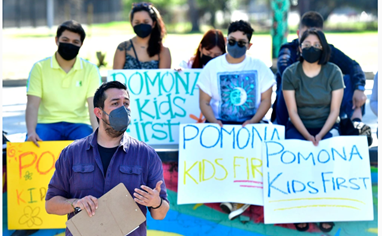
- Report on inequities in Pomona for youth
- Video with young people organizing, learning and testifying
- Poster for campaign to amend the city charter
- Pomona budget analysis by Funding the Next Generation
- Fact Sheet on Pomona Kids First
- Ballot measure to create Pomona Children and Youth Fund
- Article on campaign kickoff
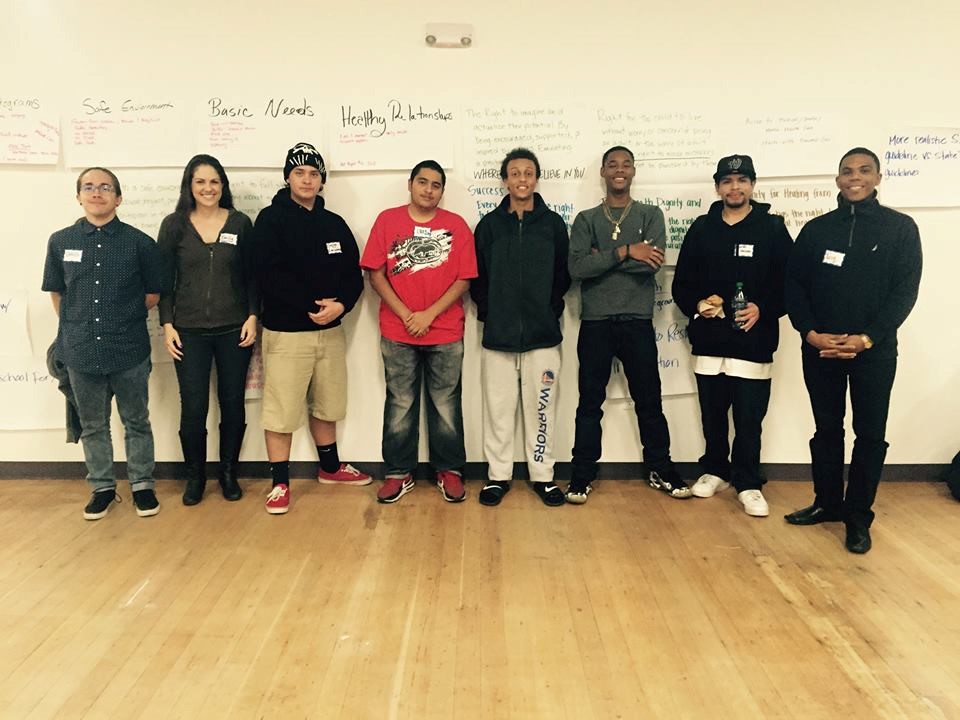
Group from Fathers and Families standing in front of their contributions to the San Joaquin Children and Youth Bill of Rights
San Joaquin County – Two campaigns getting over 60% of vote, building a diverse alliance
Starting in 2016 with a small group of children’s service providers and an energetic member of the Board of Supervisors, Kathy Miller, a new organization was born: the San Joaquin Children’s Alliance. Within a year, it had succeeded in having the Board of Supervisors adopt a formal Resolution of Commitment to the county’s children, with 150 people in the audience who had been engaged in drafting a Children and Youth Bill of Rights. The Alliance moved on to successfully advocate that a formal task force of the county be established with the purpose of developing strategies and policies for increasing funding for services.
After a year of work, the Task Force presented its report to the Board of Supervisors with 100 folks from all parts of the county in the audience and providing testimony. The major recommendation was that marijuana tax dollars be spent on prevention programs for kids. After powerful advocacy, the Board of Supervisors voted to place a measure on the ballot to tax marijuana and have 50% of the proceeds go to children and youth services. This was an astonishing victory – and set the pace for communities around the state. In November 2018, the measure received 63.5% of the vote. While this would mean passing in most states in the country, in California a 2/3 vote is required. The Alliance did not give up – far from it. The group supported the continuation of the county Task Force and the engagement of multiple players in identifying needs of kids and presented the Board of Supervisors with recommendations and priorities.
And then, in 2020, the Alliance and its many allies advocated to place the measure on the ballot again. The campaign was vigorous and poised to win until unrelated local politics intervened. The measure received 65% of the vote, but did not reach the full 2/3 required. Yet the group remains engaged – pushing child-friendly policy, expenditure of federal dollars on kids, and is strategizing the next measure.
Going from a membership base centered in Stockton, the Alliance spread throughout the County, involving Tracy, Lodi and other communities and rural areas. And, it has expanded from a focus on young children to also having youth members, who are being trained to translate their personal stories into policy and funding demands. The Alliance is also reaching beyond service providers, and is engaging the business community and other civic leaders, as well as the major educational institution in the county, the University of the Pacific.
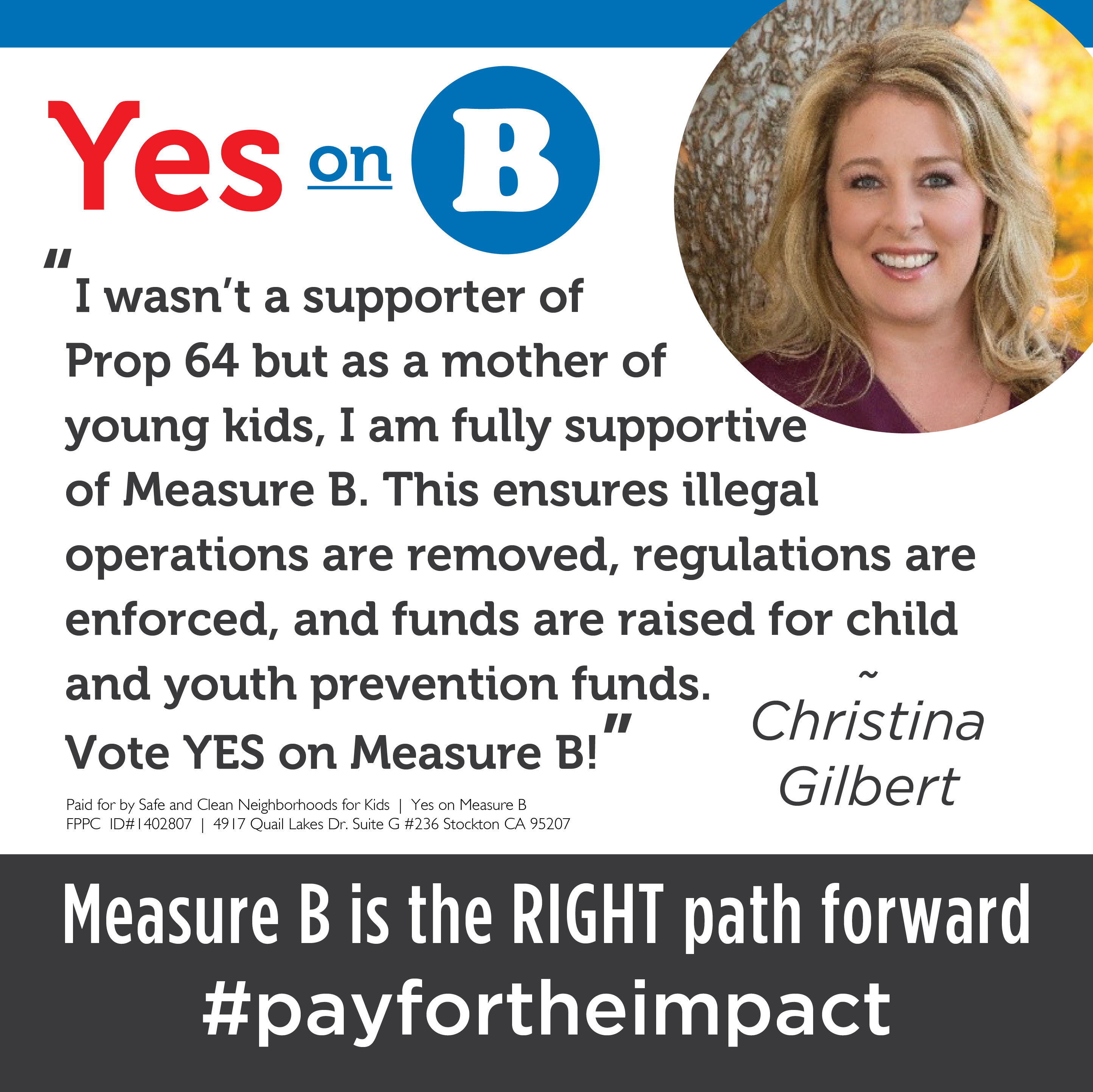 Three foundations have stepped up to support the work, at various stages: The Sierra Health Foundation, The California Endowment and the Heising Simons Foundation. Christina Gilbert is the organizer of the group – a mom with 3 kids in the public schools, new to organizing, but an old hand at herding cats and helping folks get efficiently and enthusiastically from A to B. She is a natural, and is bringing people together around kids in San Joaquin County like never before.
Three foundations have stepped up to support the work, at various stages: The Sierra Health Foundation, The California Endowment and the Heising Simons Foundation. Christina Gilbert is the organizer of the group – a mom with 3 kids in the public schools, new to organizing, but an old hand at herding cats and helping folks get efficiently and enthusiastically from A to B. She is a natural, and is bringing people together around kids in San Joaquin County like never before.
- Link to website for 2020 campaign
- 2020 campaign fact sheet
- Power point presented to Board of Supervisors on recommendations of children and youth task force, and rationale for 50% of marijuana taxes going to children’s services
- Poll conducted on public opinion about what marijuana taxes should fund in San Joaquin County
Sonoma County – Ambitious sales tax makes second try.
In 2016 the Cradle to Career initiative, convened through the Sonoma County Department of Health Services (DHS) and representing a diverse network of public and private stakeholders in child and youth development, investigated the creation of a dedicated funding stream with a focus on universal pre-school. The DHS commissioned a Portrait of Sonoma County provided comprehensive information about disparities in the community and opportunity gaps for children. With this background research completed, a citizen steering committee was formed to plan for a future ballot measure, with all options are on the table.
Sonoma First 5 provided support to the research and public education component of this effort. They explored social impact bonds, sales taxes, and cannabis taxes as ways to raise the revenue for services. At one point they thought that the best option would be a fee on single use plastics. But even before the COVID they saw that recurring natural disasters exacerbated competing priorities, particularly with fires in their county. But they kept the long view on revenue options while building their political capital. In 2020 they worked in concert with other groups to support a county sales tax for mental health and housing with the goal that children’s services would receive some of the money.
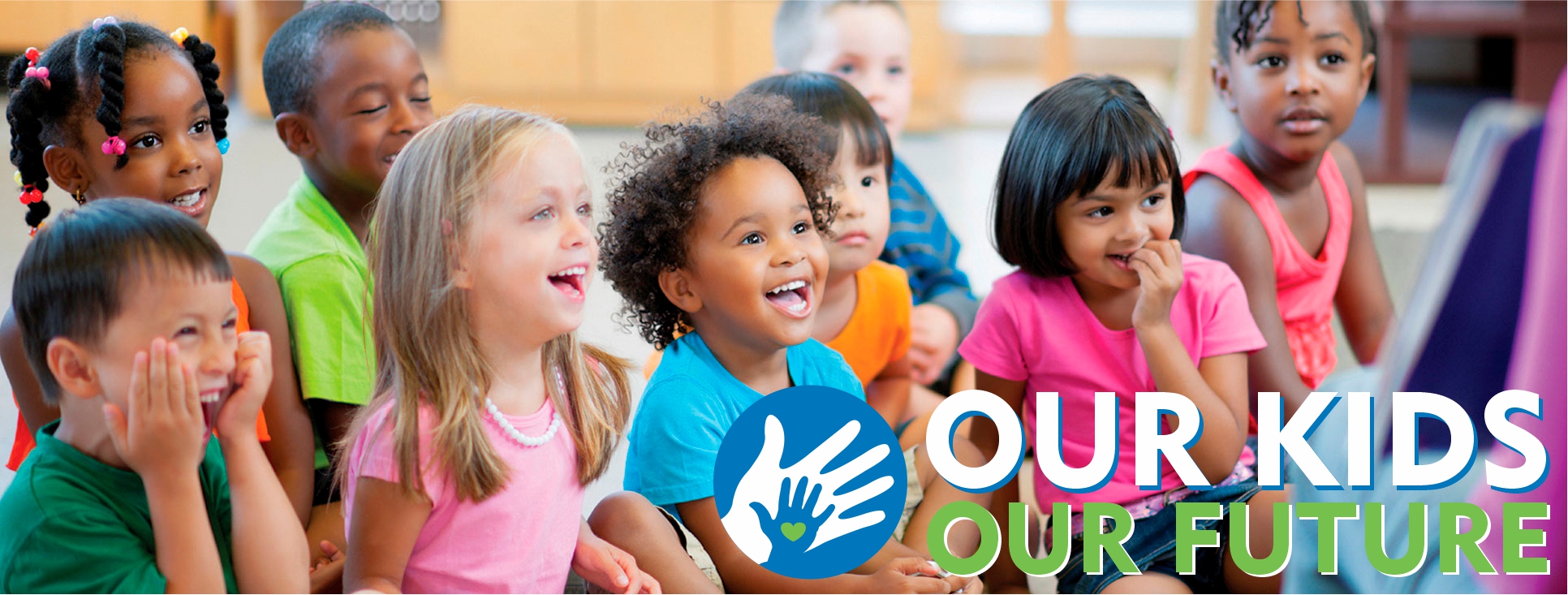
But in early 2022, children’s advocates formed their own coalition to finally place a Childcare and Children’s Health measure on the ballot to fund services for children, ages 0 to 5. As of Spring of 2022, the measure had gleaned widespread political support. It was a sales tax that would generate $22 M for early care, including childcare and health services. The coalition, Our Kids Our Future, then collected signatures for the November 2022 ballot. Sadly, they did not have enough signatures to qualify. But they have shown great perseverance and finally in the spring of 2024, they submitted enough signatures for the November ballot. The worked hard to expand their circle of endorsers and in the end, they had no formal opposition. In November 2024, they won by 61%.
- Analysis of funding options for universal preschool in Sonoma County
- Link to campaign website of Our Kids Our Future
- Link to Childcare and Children’s Health Initiative 2024
San Diego – Building a dynamite coalition to influence policy and funding
EARLY CARE – In early 2020, a coalition of early care advocates and providers, convened by the YMCA of San Diego County, made the decision to advocate for local dollars for early care. They had previously advocated only at the state level. The coalition of over 25 organizational members set as its first local priority addressing the loss of First 5 funding for the Quality Preschool Initiative. The began a campaign that included letters, meetings with decision makers, public testimony and public education. The result was groundbreaking for San Diego. For the first time ever money for child care was put into the county budget by the Board of Supervisors. The Board challenged the city to do the same, and ultimately a new $10Million came into the child care field – as it was needed at the height of the impact of the pandemic.
The group followed with a successful advocacy campaign to create an Office of Child and Youth Success at the city level (the office was created in 2022 by the City Council), and is now engaged in long-term planning and capacity-building for a county ballot measure for dedicated funding. Known now as the Children First Collective, they have become an influential voice throughout the city and county, and regularly publish reports on the status of childcare and are actively engaged in all forums related to early care. The aim to influence policy and budgets. They recently celebrated the creation of a child care division at the county level.
The Children First Collective has become known throughout the state as one of the most effective local advocacy voices for early care and education. Part of the success is due to the broad and inclusive coalition they have formed, and also to the significant staff support provided some of its key members, such as the San Diego YMCA.
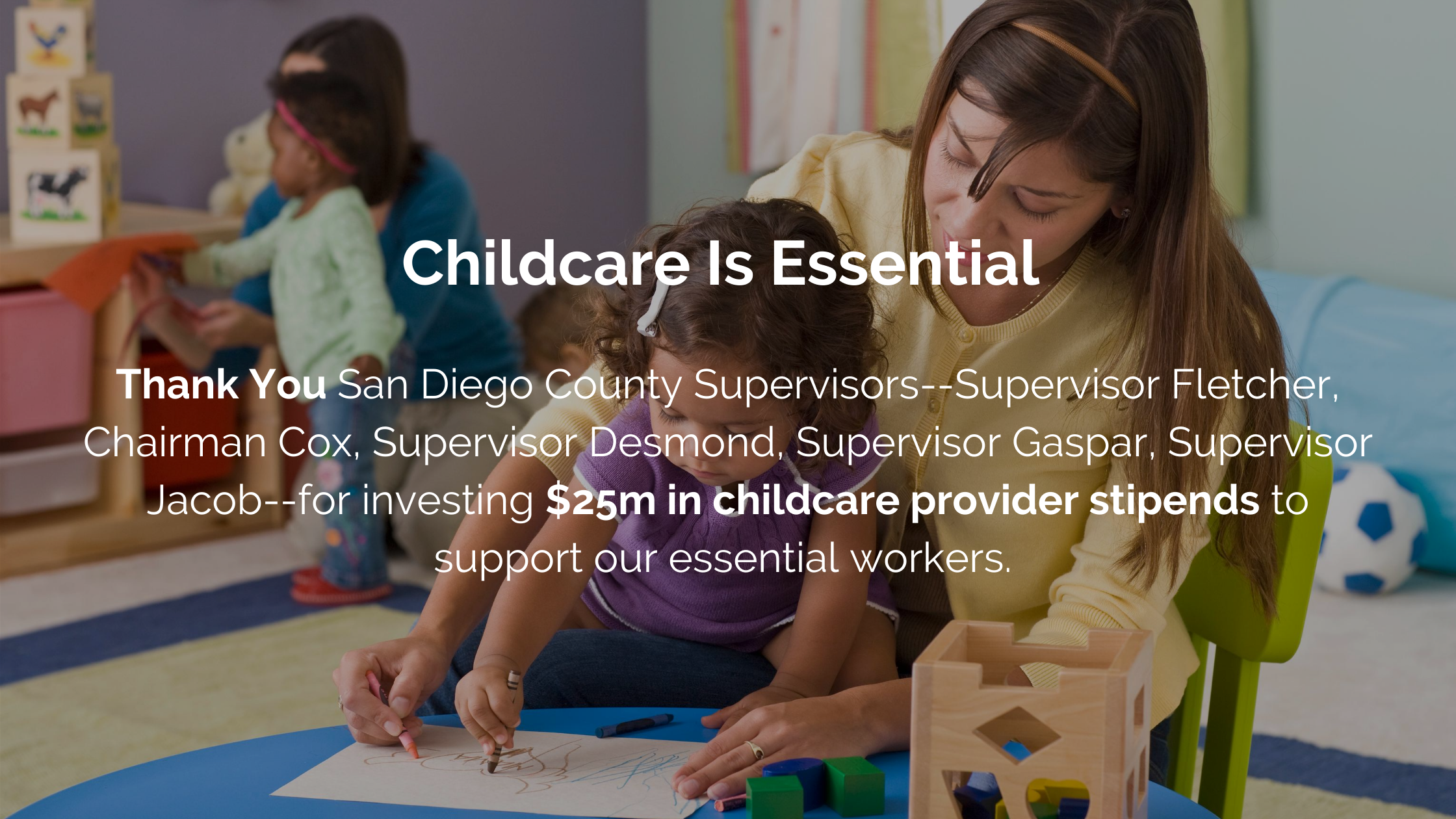
YOUTH DEVELOPMENT – A steering committee was formed in 2016 to plan for a ballot measure. 75 non-profit leaders were convened to learn about the effort, and most expressed great enthusiasm and a commitment to help. Two years later, Mid-City CAN has stepped up to lead the effort, with the hope of being on the ballot in the future. They are gaining their political chops on a variety of other measures, including police accountability campaigns, as well free youth bus passes in a transportation measure.
San Diego is an example of advocacy hubs for both youth and young children 0 – 5. They work in parallel lanes, aware of each other’s goals and strategies, and combining forces when it makes sense.
Early care advocacy and documents
- Website for Children First Collective
- Children First Collective budget recommendations to Mayor, 2023
- Summary of early care advocacy for child care dollars
- Plan for an Office of Child and Youth Success
- Website for Office of Child and Youth Success
- Press release on new Office of Child and Youth Success
- State of Child Care During COVID
Youth advocacy – Dreams of a youth fund have been around for a long time in San Diego
- San Diego Opportunity Youth Collaborative Fact Sheet
- Public opinion poll on youth development issues in San Diego.
Made It To the Ballot!
Solano County – Pioneering effort to blend tax and advisory measure
A broad coalition of children’s service providers worked for a year to get a Children’s Fund placed on the Nov. 2016 ballot. They were building on years of work coalescing service providers in the public and private sector around policy and program development, including the completion of a Solano County Children’s budget. A 2014 report card on children, created by an advisory committee to the Board of Supervisors, recommended a ballot measure for sustainable funding. An early step was a poll, funded in part by the Solano County First 5 and the United Way. The Coalition, calling itself Funding the Next Generation Solano, spent eight months drafting a measure, documenting the feasibility of their plan and presenting ideas to the Board of Supervisors. After several enthusiastic hearings, the Board agreed to place a sales tax on the ballot to fund the Solano Fund for Children. It was accompanied by an advisory measure to ensure the tax money would go to kids. The Advisory measure passed, but the sales tax did not. The group is now working at two levels: exploring what can be done in Vallejo where the measure received sufficient votes; and returning with the Board of Supervisors to urge the creation of a Children’s Budget. One new development is the engagement of a group of youth from Vallejo eager to join the campaign.

- Solano Fund Advisory Measure
- Solano Fund Mailing piece
- Facebook page of Funding the Next Generation Solano
- Solano Fund fact sheet
- Fact sheet on needs of Solano children
- Solano County Children’s Issues Poll
Napa County – blending early care and law enforcement
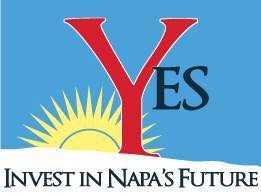 In 2015 Napa started its work with a core group comprised of representatives of the Department of Public Health, the First 5 Commission and a non-profit family support agency leading the effort to get dedicated funding. They convened 2 conferences introducing the goal of dedicated funding and creating a Children’s Bill of Rights – involving over 40 public officials and public and private service providers. They successfully advocated the approval of a Bill of Rights and creation of a Children’s Budget with the Board of Supervisors. With that work complete, they created a steering committee under the auspice of Cope Family Center, hired a coordinator for Funding the Next Generation Napa, developed plans for a dedicated funding stream and conducted education and outreach throughout the community. They negotiated with the Board of Supervisors to make children’s services a priority in a June, 2016, ballot measure for a half-cent sales tax. The measure gained a lot of attention and provided the platform for a major public education campaign – important in Napa County since so many decision-makers and influential citizens were under the misapprehension that there were no disadvantaged young people in their community. While the measure came close at 46%, it did not pass. Not planning to give up, the Steering Committee of the measure is re-grouping and planning its next steps.
In 2015 Napa started its work with a core group comprised of representatives of the Department of Public Health, the First 5 Commission and a non-profit family support agency leading the effort to get dedicated funding. They convened 2 conferences introducing the goal of dedicated funding and creating a Children’s Bill of Rights – involving over 40 public officials and public and private service providers. They successfully advocated the approval of a Bill of Rights and creation of a Children’s Budget with the Board of Supervisors. With that work complete, they created a steering committee under the auspice of Cope Family Center, hired a coordinator for Funding the Next Generation Napa, developed plans for a dedicated funding stream and conducted education and outreach throughout the community. They negotiated with the Board of Supervisors to make children’s services a priority in a June, 2016, ballot measure for a half-cent sales tax. The measure gained a lot of attention and provided the platform for a major public education campaign – important in Napa County since so many decision-makers and influential citizens were under the misapprehension that there were no disadvantaged young people in their community. While the measure came close at 46%, it did not pass. Not planning to give up, the Steering Committee of the measure is re-grouping and planning its next steps.
- Napa County Budget Analysis slide show – 2020
- Funding the Next Generation Napa: Link to Facebook page
- Napa’s launch: PowerPoint presentation for Funding the Next Generation Napa
- Napa County Children’s Bill of Rights approved by Board of Supervisors, 2015
- Napa County report on status of children, 2015
Marin County – Early effort comes close
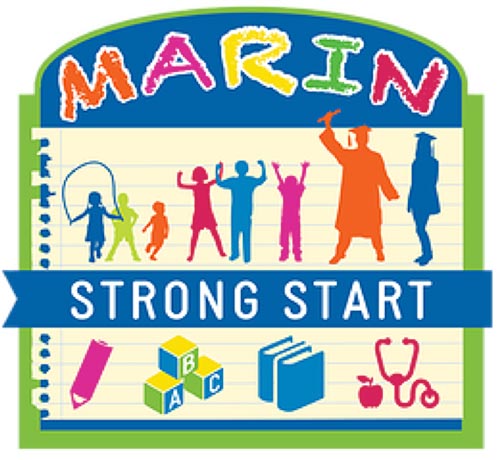 Marin County was the first place to step forward to place a funding measure for kids on the ballot in this new phase of the children’s funding movement – i.e. post the pioneering work of San Francisco and Oakland. For almost 7 years they prepared for the 2016 ballot for a sales tax dedicated to services for young children. Spurred by First 5 Marin, in 2009 a group of civic, non-profit leaders, along with a few representatives of elected officials, formed MarinKids to study the funding needs and options, and develop a plan. They hoped to be on the ballot in 2012, but postponed the measure to 2014 due to a competing measure. They creation of this coalition of organizations and local leaders was the essential element of the effort – critical to getting broad buy-in for a children’s agenda and building the case. In preparation for the 2016 campaign they formed StrongStart to spearhead the actual campaign. They received 63% of the vote – short of the 2/3 needed. The entire effort was a model for the field in many ways. In retrospect some of the leaders involved felt the effort might have lacked the grassroots outreach needed.
Marin County was the first place to step forward to place a funding measure for kids on the ballot in this new phase of the children’s funding movement – i.e. post the pioneering work of San Francisco and Oakland. For almost 7 years they prepared for the 2016 ballot for a sales tax dedicated to services for young children. Spurred by First 5 Marin, in 2009 a group of civic, non-profit leaders, along with a few representatives of elected officials, formed MarinKids to study the funding needs and options, and develop a plan. They hoped to be on the ballot in 2012, but postponed the measure to 2014 due to a competing measure. They creation of this coalition of organizations and local leaders was the essential element of the effort – critical to getting broad buy-in for a children’s agenda and building the case. In preparation for the 2016 campaign they formed StrongStart to spearhead the actual campaign. They received 63% of the vote – short of the 2/3 needed. The entire effort was a model for the field in many ways. In retrospect some of the leaders involved felt the effort might have lacked the grassroots outreach needed.
Finding Creative Alternatives
Several communities have sought revenue in creative ways that have not led to a ballot measure dedicated to children and youth, but have included mitigation efforts related to cannabis (Yolo) and partnering with their city or county on a general fund measures and advocating for a portion of the funding for children and youth (Contra Costa and Long Beach).
Yolo County
In 2017, the Yolo County Office of Education spearheaded a planning process for a preschool ballot measure. A strong steering committee was formed and a draft of the measure was completed. Unfortunately they faced political and funding barriers they felt they could not overcome. The measure has been drafted and hopes continue that circumstances will allow it to go to the ballot. Meanwhile First 5 Yolo has stepped up to the plate, leading innovative strategies to create city and county development agreements and other strategies that would raise revenue with the cannabis industry. They are also working to maximize use of the Mental Health Services Act funding.
Keeping the momentum going: The County Office of Education took the lead with a member of the Board of Supervisors in bringing all elected officials together in 2021 to collaboratively plan for the use of federal dollars for children. 21 elected officials signed on to a joint op-ed announcing this collaboration – an amazing feat.
- Concept paper for Preschool for All in Yolo
- Preschool Measure drafted in 2018 – an excellent model
- The Yolo Story – powerpoint by Jesse Ortiz, Superintendent of County Schools, Yolo County
- Op-ed signed by elected officials from all major cities, the County, and the school districts
Long Beach
Khmer Girls in Action has been leading the charge in Long Beach for a children and youth fund since 2017. They analyzed the city’s budget expenditures for kids and learned that only 5% is allocated to youth development programs. They went on to survey 750 Long Beach residents on what resources and programs were needed in their community and found a major disconnect between what residents valued as priorities and how funds were spent. They work collaboatively with the city to establish the fund and also as strong outside voices for change. They succeeded in getting the city to put a placeholder in the budget for a Youth Fund and put a modest amount of money in the fund.
Khmer Girls in Action contemplated numerous types of revenue strategies for a ballot measure – a soda tax (pre-empted by state legislation), a real estate transfer tax (that proved not to be legal to be a special tax), and a voter-initiated set-aside (and then the pandemic hit). Then for the 2020 election, they worked with the city to place an oil tax on the ballot. While it is a general tax, it is anticipated that much of the funding will go for youth. Their aspiration is ultimately for a voter-approved dedicated funding stream, and they are beginning work for a future ballot. Meanwhile the city has established the Long Beach Office of Youth Development. With a small dedicated staff that reflects the community, the office is empowering youth voices, has created a strategic plan and is thinking ahead about a ballot measure.
- Video of Invest in Youth campaign in Long Beach
- Summary of survey results
- Summary of survey results
- Power point on 2020 campaign
- Long Beach Office of Youth Development
Contra Costa
Advocates for children in Contra Costa County have aspired to have a children’s fund for many years. Supervisor John Gioia has been an longtime ally of this effort. Advocates have joined with other human service providers and organizers to form the Contra Costa Budget Justice Coalition – which advocates for resources and transparency in the budget process. Their big success in 2019 was to get the county to increase funding for non-profits through more effective use of, and “drawing down” of, state funding, such as Mental Health Services Act funding. Linked below is the report they wrote that led to the funding increases.
A related development in the county grew out of community advocacy in 2020 – the county’s first increase in taxes (in this case a sales tax) in many years. Early care advocates coalesced to play a major role in the effort – getting a seat at the table at the beginning of the process. They demanded that early care be prioritized in the campaign and children’s needs were featured in campaign literature. The group was still at the table after the passage of the measure (by 58%) as money was being allocated. They have had to fight harder than they anticipated and than many policymakers promised. But they intend to stay involved as budget advocates from now on.
Building Capacity and Coalitions
Los Angeles
In late 2018, a coalition, New Fund for Children and Youth, was formed in Los Angeles to explore the feasibility of a dedicated children and youth fund in the county. The Coalition represented more than 40 organizations providing services for young people, ages 0 to 24. A Steering Committee met throughout 2019 and 2020, and selected the Children’s Health Councils as its backbone, sponsoring organization. The Coalition was built on the work of many organizations and coalitions fighting for adequate funding for positive child and youth development, including the Youth for Justice Coalition, Khmer Girls in Action in Long Beach, and First 5 Los Angeles. While the coalition is no longer meeting, it served the function of keeping a dream of a dedicated youth fund going. It will serve as a good foundation as the city moves forward trying to figure out how to bring more dedicated funding for children, youth and families to the city and to the county.
In the Summer of 2020 at the height of public outrage about the George Floyd murder, a coalition of long-time social justice advocates came together and proposed a radical idea – that 10% of the county general fund (about a billion dollars) be set aside for community investments, including and featuring youth development and alternatives to incarceration. After strong community advocacy, the Board of Supervisors placed the measure on the ballot for November 2020 and it won. The campaign, called Reimagine LA, was groundbreaking and will be an inspiration throughout the country. County labor unions unfortunately filed a lawsuit challenging the measure and won in their first round in court. The judge ruled that voters can’t initiate budget set-asides at the local level since they might interfere with the county’s ability to implement state mandates. The good news is that the LA County Board of Supervisors agreed to implement the measure anyway. There is great hope that the higher court will reverse this decision.
On another front at the city level, after years of advocacy by Legacy LA and homework about how budgets short-change youth, the City Council voted to create a Department of Youth Development. This is a major step toward a dedicated fund. The new Department has gotten off to a rousing start under the leadership of Lisa Salazar. It has put great focus on creating a vibrant youth council.
And, at the other end of the age spectrum, meetings have been convened about an early care measure. The most recent convening has been organized by LA Partnership for Early Childhood Investment.
- Fact sheet on New Fund for Children and Youth (LA’s campaign for dedicated funding)
- History of dedicated funding measures in Los Angeles
- Early goals and objectives of New Fund for Children and Youth coalition
- Link to article about new Department of Youth Development
- Legislative language to create new Department
About Reimagine LA:
- Link to website
- Ballot measure language
- First funding allocation plan
- Judge’s ruling about the measure – now being appealed by LA County and the measure’s advocates
San Bernardino
The Inland Empire Community Collaborative, a broad network of non-profits in San Bernardino County and other parts of what is known as the “inland empire,” was formed to make a collective impact in its related communities through collaboration, leveraging and resource development. They aspire to have a dedicated revenue stream for the young people of their partnering counties. They have created what they call a Children’s Cabinet, a group of leaders on children’s issues from both Riverside and San Bernardino County. The group is vibrant and actively raises money, receives training and is engaged in developing a policy agenda.
- San Bernardino budget analysis provided by Funding the Next Generation to support their goals
- Link to Children’s Cabinet of Riverside and San Bernardino Counties
- Website of Inland Empire Community Collaborative
Fresno
Several parallel conversations about dedicated funding for kids have occurred in Fresno for the past several years. One effort was organized by the Fresno branch of EBAYC. They aspired to follow the Oakland model for creating a youth fund, and completed a needs assessment survey to over 1700 youth to create foundational information for a future funding measure. Social justice organizations met for several years in an effort to spark momentum for a ballot measure. Meanwhile, in 2018 advocates for parks placed a sales tax measure on the city ballot to fund parks – which did not get the 2/3 vote needed. The Fresno City Council declared that the measure had lost, but advocates went to court to try to overturn the Council’s decision arguing that the measure had been put on the ballot through a voter initiative and therefore only required a majority vote. In 2020 an appellate court ruled that the measure had actually passed. The decision became one more landmark in a series of decisions that held that revenue measures placed on the ballot through voter signatures required only a majority vote.
Since 2016 the Cradle to Career initiative has been working to lay out a comprehensive blueprint for the young people of Fresno County. They then organize collaborative action networks to move from blueprint to action. They have become a vibrant “table” bringing together 71 organizations to create equitable systems for Fresno’s children. They have a long-held vision of revenue streams to support the goals of the community. They took bold step in 2021 by working with the Fresno Children’s Movement to organize a 100 strong Resident’s Council that they hope will become a powerful grassroots voice for change.
- Link to Cradle to Career info graph
- Website of Cradle to Career Fresno County
- COVID19 Equity Project slide show
- Article on Appellate Court decision in favor of Park Measure, includes some history on the series of court decisions
- Short video on the creation of a Fresno Resident’s Council
Santa Clara County
A Strong Start Coalition, spearheaded by the County Office of Education, in collaboration with community advocates, service providers and the Silicon Valley Community Foundation, have been aspiring to have a Preschool for All measure for many years. They have kept the dream alive despite many political and resource obstacles. They continue to work with county leaders and elected officials to get funding for early care. Stay tuned…….
San Benito
First 5 San Benito is launching its revenue strategy working in coalition with with multiple partners, including young people. It started as a successful effort to create a Family Impact Center in the county. They hope to move on to create a collaborative space, a community center, for many services and agencies and use a ballot measure to fund the space. Partners include county agencies, county sheriff and probation, and the school district. This coalition will serve them well as they move on to get dedicated funding.
Link to concept paper on Community Center
Early Efforts
City of Merced
In 2014 a coalition organized through Building Healthy Communities began an Invest in Merced’s Youth campaign, that is still going on.
- Link to Invest in Our Youth Facebook page – still active
- Preliminary Initial Timeline for Merced youth budget campaign
- First Invest in Youth Coalition Proposals for City of Merced
Del Norte County
In 2015 First 5 Del Norte has led the effort to advocate for and create a Children’s Budget, that includes a resource map of existing services and an analysis of funding allocated to prevention versus late intervention. It is now a tool for the community and the Board of Supervisors to use during annual budget processes.



